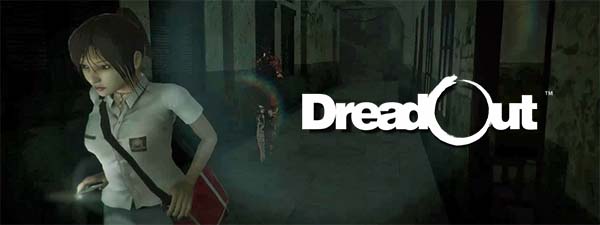
The opening moments of DreadOut set the bar pretty low for what was to come. The visual quality varies wildly. The main character, Linda, looks and animates decent enough, but the other characters all look incredibly stiff and robotic. And they sound almost as stiff and robotic. I'm not sure if it's a matter of poor translation, cultural disconnects, or if it's a deliberate attempt by the developers at camp, but the dialogue and voice acting is cringe-worthy. It wasn't even laughably bad. It was just bad. Don't worry though, you won't have to put up with them for long. They'll disappear for the majority of act 1, rendering the game's futile attempts at early character-building moot, and likely leading to you forgetting that they ever existed until they reappear later. The ghosts and monsters themselves actually get better development and depth, as each one is given a thematic backstory, and its aesthetic design attempts to represent that theme - with varying degrees of success.
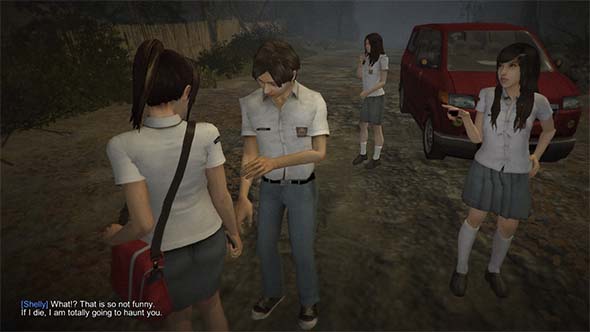
Dialogue and voice-acting might have been going for deliberate camp, but ends up just being bad.
It's an indie game, so I don't expect its graphics to impress on any technical level. But what's presented on screen is often only passable for a PS2-era game, and there's very little artistry or detail in the majority of environments. Some of the environments are decent, and there's the occasional well-placed lighting or particle effect that helps to set a mood. That mood rarely lasts though, because you'll turn a corner and find repetitive environments and flat textures. It is very easy to get lost in a few areas of this game because so much of the environment looks the same. The school building was particularly bad, as all the classrooms had the same desks, chairs, and backpacks sitting around. Only two rooms in the entire building had unique decorations (a teacher's office and what appeared to be a biology lab). The difficult-to-read signposts and lack of any sort of in-game map just exacerbates the sameness of the game's environmental design.
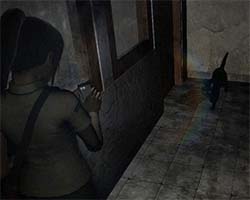
"Aw, hello Mr. Kitty!"
Oh, you're a black cat and are
supposed to be scary. My bad..
Gameplay is less a mixed-bag, and is more universally terrible. Movement is very clunky. The camera loves to pivot around when you go through doors, leading to temporary disorientation as you try to figure out which direction the character is facing. It doesn't help that so much of the game looks the same, so it's easy to get turned around and confused (or outright lost) when the camera wigs out on you.
There's a blue vignette effect that indicates a nearby item that is designed to work as a player aid, but sometimes it can be a hindrance. It works through walls, which I guess is fine since it can let you know that you need to go into a nearby room. What isn't fine is that it also seems to work through floors and ceilings. So the game will nag you that a useful item or clue is nearby, but it might be on a different floor of the building. So you end up wandering back and forth trying to find it - which you never will because it's not there... [More]
175d6d05-3fa8-4f7e-ad1b-458c00a80c3c|4|3.5
Tags:DreadOut, Digital Happiness, horror, indie gaming, Steam, Indonesia, ghost, school girl, camera, cell phone, photograph
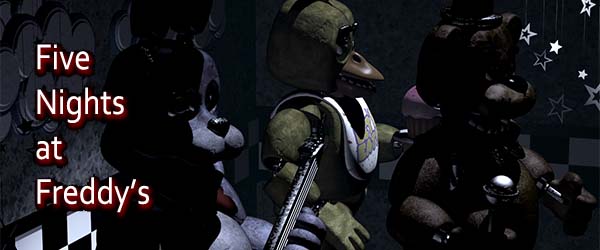
Five Nights at Freddy's was recommended to me by some friends a couple years ago. They knew that I was interested in horror games, and that I was disappointed with the stock of horror games that were available at the time. I bought it at the time, but never got around to playing until recently.
The concept for the game is quite a good one. You work as a night watchman of a Chuck E. Cheese-style children's birthday party center. By day, there's four animatronic animals along the lines of Disney's Country Bear Jamboree that dance and sing songs to entertain children; but by night, these animatronic animals come to life, stalk the halls of the facility, and have been known to attack and kill anybody that they find. This is definitely the stuff of nightmares, and if your young child ever plays the game (or sees you playing it), he or she might never want to go to Chuck E. Cheese or Disneyland ever again. But as an adult, the game just doesn't quite do it for me.
I think the core problem is that the whole experience is built around providing semi-random jump scares. It might cause someone to jump the first one or two times it happens, but after that, you get pretty quickly desensitized to it. And once that happens, the game loses all of its effectiveness, even though it doesn't necessarily lose any of its borderline-unfair challenge.
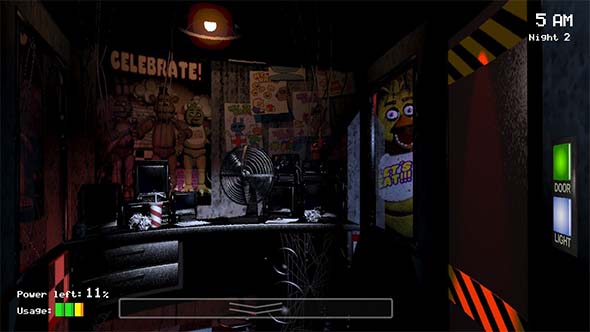
Keeping the security doors closed consumes power, sacrificing your long-term security.
You must spend five nights sitting in a security control room. There's two security doors and a series of camera, but there's also a limited supply of dwindling power. Closing the doors consumes power, looking through the cameras consumes power, turning the lights on consumes power. And if power runs out, you are left sitting in the dark for the rest of the night with no defense against the monstrous mechanical mascots.
The amount of nightmare logic that is required just to establish the setting is actually kind of interesting in its own right. What kind of a place operates with dwindling power? How poorly-maintained is this facility? How does it maintain power during the day? Is it even safe for kids during the day? Why would the doors require power to stay closed? You also get voicemails each night from the former night watchman, who casually talks about the increasingly-complex behaviors of the mascots, new strategies for dealing with them, and so on. These phone messages are very well-acted and well-delivered. All of this contributes to the game's incredible uncanny setting, and everything seems to be in the perfect place to create an incredible horror experience based on powerlessness and creeping tension.
But then the actual gameplay starts, and the excellent atmosphere starts to buckle... [More]

A few weeks ago, Firaxis and 2K Games ensured that fall of 2016 is going to be very busy for me. They announced Sid Meier's Civilization VI, which is due out October 21. Believe it or not, my reaction to this was actually a little bit mixed. While a new Civ game is obviously exciting, I have to fight back a feeling that it's too soon.
For one thing, I was expecting at least one more expansion for Beyond Earth, which I feel still has some annoying holes in its gameplay (most notably, its air units and generally dull orbital layer). If those holes were filled, and if the game's map could change over the course of the game, then Beyond Earth has the potential to rise out of mediocrity and stand at the same level as Civ V as a unique and engrossing sci-fi strategy game. Now, that looks very unlikely. Since the first expansion (Rising Tide) would expand the shallow naval and ocean gameplay, I had expected that a second expansion (which I had personally code-named "Falling Skies") would expand air units and orbital gameplay and maybe add flying cities.
Sean Bean introduces us to Sid Meier's Civilization VI - due October 21st.
The other reason that I felt Civ VI is too soon is because I was still hoping to get back into modding for Civ V. I still had one massive mod that I've been working on off-and-on for years that just needed some bug fixes and polish before I could release it. I had put off finishing it until after I'd completed my series of strategy guides for Civ V, and I was hoping for a few years in between games so that I could finish the mod and have time for people to play it. But now that Civ VI is announced, I feel less motivated to bother with that mod, since most players (including, most likely, me) will move onto Civ VI come October anyway. Maybe I'll work up the motivation to get that mod out anyway; we'll see. In any case, I'll hopefully get more into modding for Civ VI earlier so that I can release more content for that game, and maybe make some more ambitious projects...
The good news is that Civ VI does look to be fulfilling one of my wishes of being more focused on empire-management... [More]
a923a46b-608d-45e4-84d5-b592b2684a88|3|4.7
Tags:Sid Meier's Civilization, Civilization VI, Firaxis, civilization, 2K Games, strategy, history, hexes, city, districts, wonders, Theodore Roosevelt, Civilization: Beyond Earth, Civilization: Beyond Earth: Rising Tide, Civilization V, PC, Steam, Ed Beach, Sean Bean

Now that I've gotten through the gauntlet of massive AAA releases like Metal Gear Solid V and Dark Souls III, I wanted to take some time to clear out some smaller games that have been collecting dust in my Steam library before diving into any other massive, time-sucking games. One of my highest priorities was the Indie sci-fi horror title Soma, developed by Frictional Games - the same company that made Amnesia: the Dark Descent. I had heard pretty good things about this game, and I liked Dark Descent, so I was eager to finally have a chance to dive into this one.
Learning from failures and forgetting successes
Soma show signs of learning from the weaknesses of both The Dark Descent and A Machine for Pigs (which was actually developed by a third party), even though it still doesn't necessarily nail the mechanics this time either. It's a far better experience than Machine for Pigs, and shows the level of quality that helped make Dark Descent such a hit. The most notable improvements from Machine for Pigs is in the depth of gameplay and monster encounters; and the most notable improvements from Dark Descent are in puzzle design and narrative.
Second chances
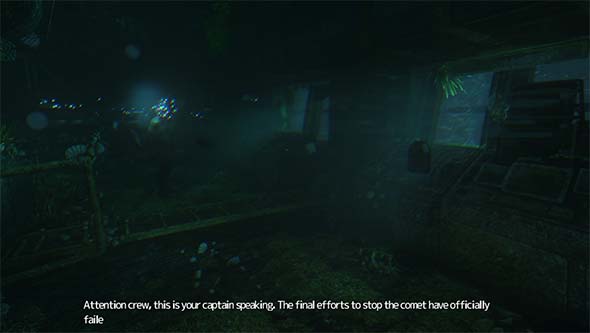
Monsters sometimes appear in where you get important story bits to incentivize you to not just walk away.
Monster encounters do still feel very un-threatening for the first half of the game. The first few monster encounters even seemed scripted to catch the player. This was possibly done in order to tutorialize the game's healing mechanic, but it also serves to desensitize the player to the monster and the threat of death right out of the gate. Unlike The Dark Descent, you don't start out terrified and cowering in fear from a mysterious and ominous enemy that can kill you in a heartbeat, and then gradually grow desensitized to it as it kills you and you realize that the consequences of death are pretty minor. Instead, you're taught right from the start that dying is virtually consequence-free, and that it isn't really worth the time and effort to try to avoid the monster by sneaking around, or to try to hide from it. The monster's appearance is never even surprising either. There's a screen-tearing effect and static noises to indicate that the monster is near, even if you can't see him. It's the same kind of effect that Slenderman played with. So even while you're walking around, you never feel the need to peek around corners or glance over your shoulder to make sure nothing's stalking you. This kills any potential for horror that the game might have been able to establish... [More]
fe37316f-173d-463b-a214-2d614c72dff2|1|5.0
Tags:Soma, Frictional Games, Steam, indie gaming, mind, consciousness, mind-body problem, transhumanism, robot, artificial intelligence, ocean, abyss, Amnesia: the Dark Descent, Amnesia: a Machine for Pigs, The Swapper, science fiction, Philip K. Dick, Turing Test, ludonarrative
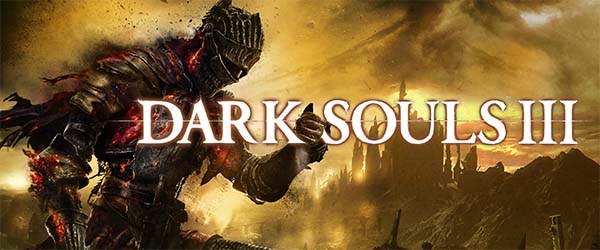
PC elitists now have yet another bragging point. Considering that Bloodborne ran smoothly at 30 frames per second on the PS4 (from my experience), and that Dark Souls III was supposedly built upon that same engine, I expected that the PS4 version would perform on par with (or maybe even better than) the PC version. I was wrong. Both console versions of Dark Souls III are capped at 30 fps, but their actual performance doesn't even meet that standard. This is a big problem considering that the game plays almost as fast as Bloodborne. Dropping a few crucial frames of enemy attack wind-ups can mean the difference between a successful dodge or parry, or losing a third of your health to a single attack. Bloodborne had the load screen issue that was that game's near-debilitating "known shippable"; and now Dark Souls III has its console framerate as being the major launch issue that must be fixed. At least Bloodborne's problem didn't impact actual gameplay...
Table of Content
A challenge to Souls fans
This is probably the hardest game in the lineup. In fact, it may even be too hard in some ways. Enemies are very aggressive and relentless, they are very fast and swift at attacking, and they are very good at tracking your movement during an attack. I feel like the game is sadly front-loaded with excessive difficulty. Oh, don't get me wrong! It's hard throughout, and there's still some definite mid-and-late-game peaks of difficulty. But this game easily has the highest barrier to entry of any game in the lineup.
Dark Souls III is very hard and very much front-loaded with difficulty.
It's one thing to provide a challenge, but the early levels of this game maybe cross the line into outright cruelty. If I weren't already invested in the series, I might not have even made it past the Lothric knights in the High Wall. Yeah sure, Demon's Souls had the Red Eye Knights, and Dark Souls had the Black Knights, and Bloodborne had the warewolves; but in those cases, those difficult enemies were blocking optional paths and items. This is why I can kind of tolerate the mutating tentacle monster on the rooftop that hits very hard, has a ton of HP, obscures half the screen, and causes an annoying framerate drop. Yeah, it's located in a critical path of the level, but it can be easily avoided and is basically just guarding a crystal lizard. The difficult Lothric knights, on the other hand, are placed in critical bottlenecks that must be passed as part of the necessary path of progression through the level, and they will shred new players to pieces! Heck, even that fat, winged knight going around in circles in the courtyard is easier than the Lothric Knights.
And then you get to the Undead Settlement, which is a maze full of ambushes and difficult enemies. Those fat evangelists and the large cleaver undead hit hard and have deceptively long reach and multi-hit combos. This is at a time when your HP and stamina are so low that you can't reliably block their attacks. Their long reach and relentless aggression means you can't back away either. So you're stuck having to stick to close range and roll through their attacks - a maneuver that can result in a quick death if you make but a single slip-up. I had a lot of trouble handling these enemies (as I was still getting used to the new timings for dodging and parrying, and the stamina requirements for blocking), and so I imagine that many rookies will likely be completely overwhelmed.
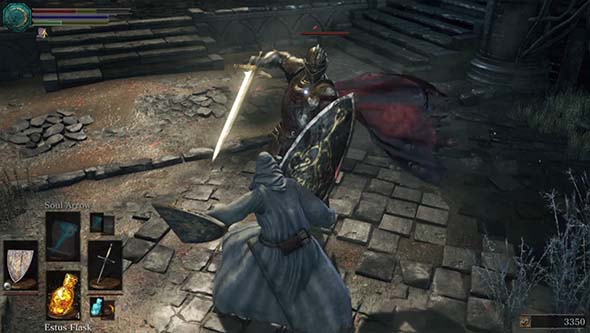
Dangerous enemies have narrow windows for parrying their attacks, making it hard to practice this technique.
There's a higher skill floor than in previous titles, and the game demands a further degree of mastery of rolling, stamina management, i-frames, and weapon movesets that previous games simply didn't require. Bloodborne also toes with this line, but Dark Souls III seems to go a bit further. The problem here is that enemies become far too fast and deadly far too early in the game, and the player character remains slow and relatively weak. What's worse is that the game breaks with the original's insistence on fair difficulty by apparently completely failing to enforce the rules regarding stamina for enemies! This was also a problem in Dark Souls II, but it didn't bother me quite as much because those enemies had slower attacks that were generally easier to dodge.
There's no gradual ramping up of challenge for the player to learn things like roll and parry timings, and there aren't any large, slow enemies to practice these techniques against. Bloodborne had very fast enemies to go with its very fast combat, but the character was also equally fast. Bloodborne also had the Brick Trolls, whose telegraphed attacks gave plenty of opportunity to practice parrying in the very first level while still making progress. Dark Souls III simply doesn't have this. There's the undead spearmen that are easy to parry, but they're so slow and defensive that you'll likely just get bored waiting for them to attack and miss your opportunity to parry. Sure you could go back to the tutorial level to practice parrying, but then you're not making any progress. There's also a lot more instances early of mobs, including the presence of difficult casters (or even bosses) being among those mobs. Fortunately, the boss is very slow and lumbering, and the casters have good audio cues for when they're casting that help to make these mobs less frustrating to deal with.
The big, armored elephant in the room
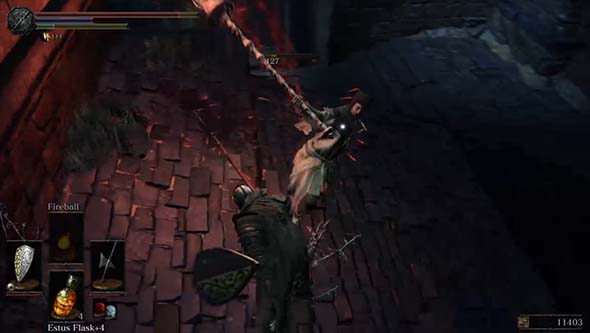
Poise has been disabled for players, which means enemies will always stagger you, but you might not stagger them.
Perhaps the biggest contributor to the game's difficulty early on is the completely baffling way in which poise and defense work - which is that they don't. In addition to not being able to upgrade armor to improve its defenses, the poise stat appears to have been completely disabled for all players in the game's code for ... some reason. Poise was one of the best additions from Dark Souls 1, and its apparent removal completely baffles me. Is it bugged and they're planning on fixing and enabling it later via a patch? Is it planned to be part of DLC? "Hey, want poise back? Pay $15 for this DLC!" The value still shows up in the UI, and there's still rings and weapons that exclusively improve poise, so it definitely seems like FROM intends for poise to be in the game. The enemies seem to still have poise, so this situation seems completely unfair. This might be part of the reason why the start of the game feels so difficult, since those damned speedy Lothric Knights can hit through your attacks, but you can't hit through theirs! [More]
fad05dd1-7cd5-454e-9102-9178f6fa617e|5|3.6
Tags:Dark Souls, Dark Souls III, From Software, Namco/Bandai, PlayStation 4, PSN, XBox One, XBox Live, PC, Steam, online, multiplayer, co-op, PvP, invasion, phantom, covenant, Lord of Cinder, Firelink Shrine, Demon's Souls, Nexus
|

| 12 | | | | | | | 60 | | 11 | | | | | | | 55 | | 10 | | | | | | | 50 | | 09 | | | | | | | 45 | | 08 | | | | | | | 40 | | 07 | | | | | | | 35 | | 06 | | | | | | | 30 | | 05 | | | | | | | 25 | | 04 | | | | | | | 20 | | 03 | | | | | | | 15 | | 02 | | | | | | | 10 | | 01 | | | | | | | 05 |
|